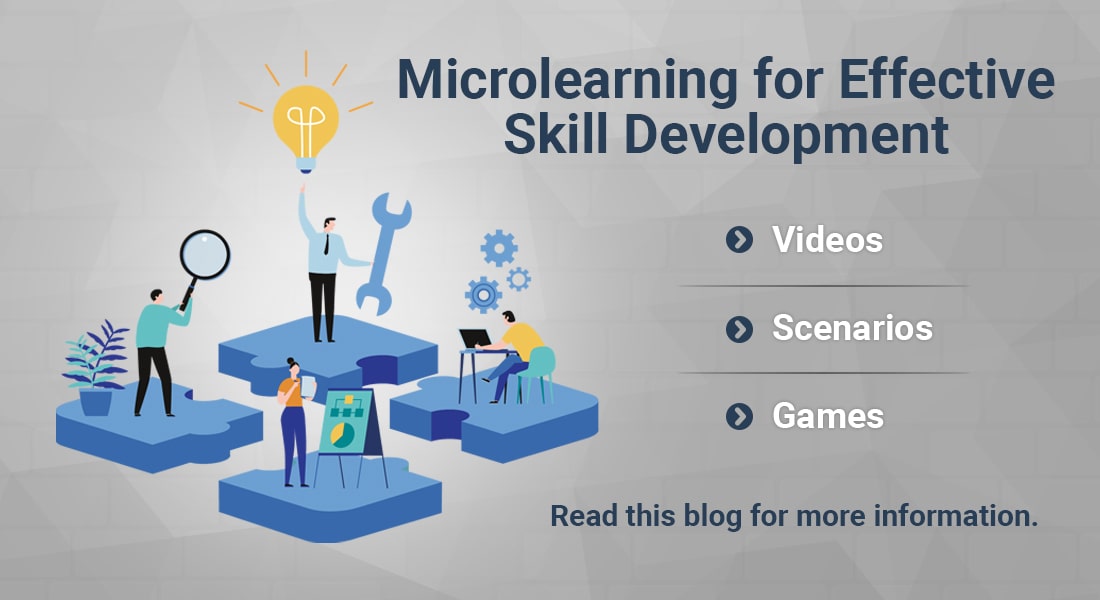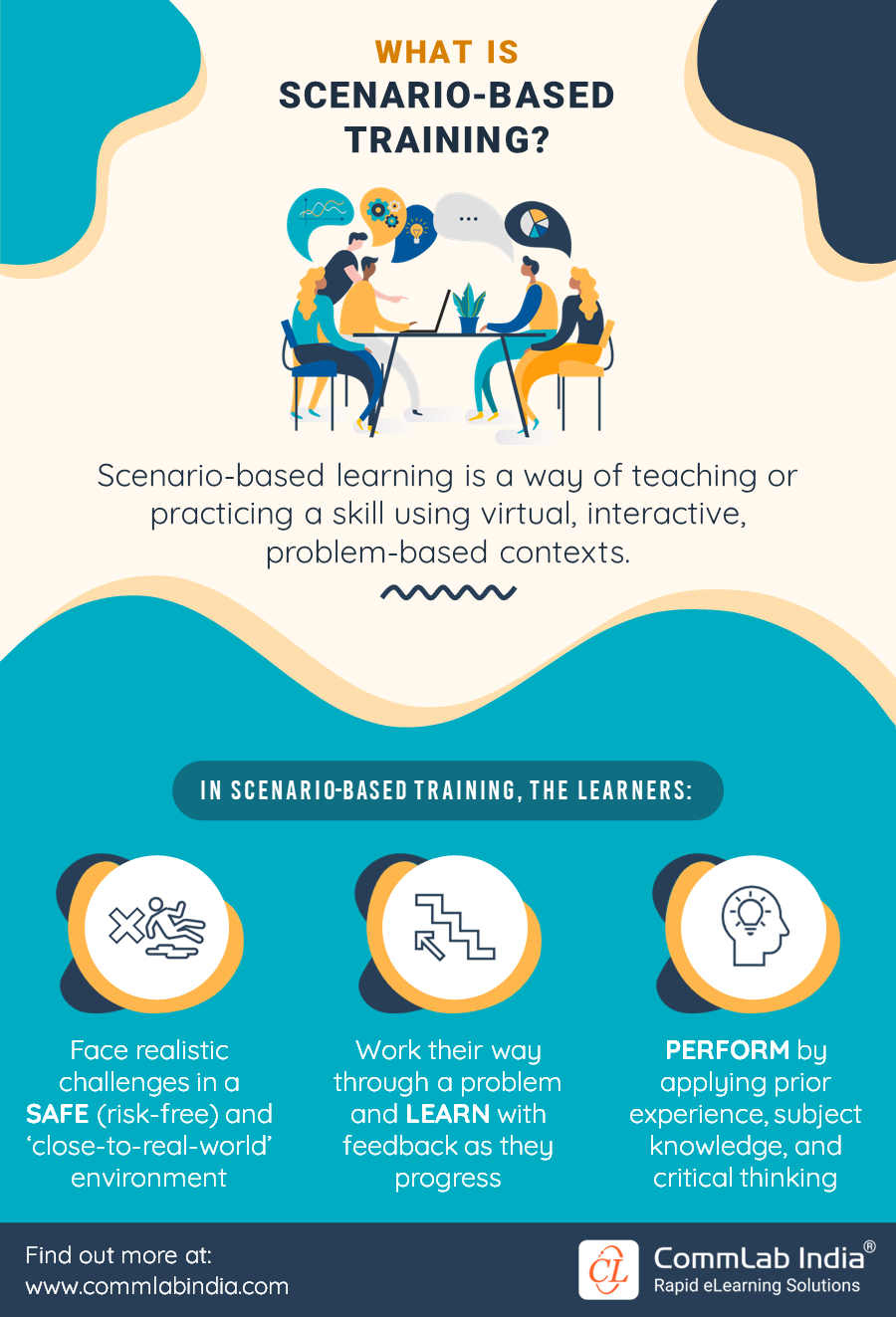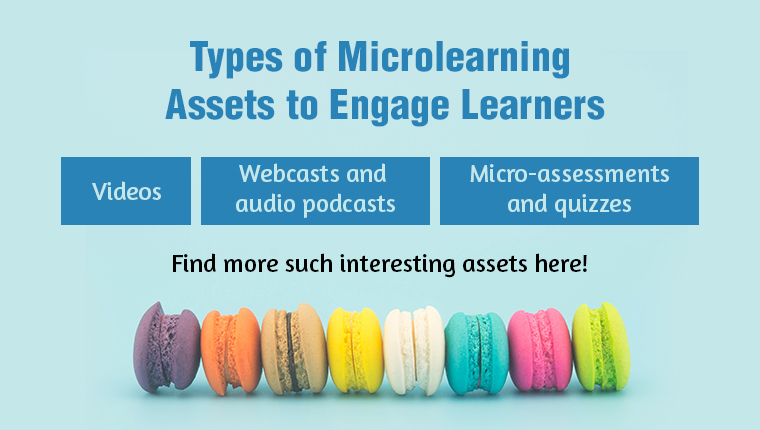Microlearning: The ‘Bite-sized’ Formula for Skill Development Training

If I were to ask you what the primary goal of corporate training is, you’ll most probably respond with ‘skill development’. And it is indeed correct. According to Udemy’s report, “Workplace Learning Trends”, 62% of organizations reported that their primary goal for 2021 is to close skill gaps. The increasing focus on skill development across the globe, especially with the pandemic still going strong, begs us to look for newer, more effective, mobile, virtual training approaches. And in my opinion, microlearning is currently the best solution for workplace skill development.
Click here to access a free webinar on microlearning implementation in the organizational training plan.
4 Microlearning Assets for Organizational Skill Development
- Videos
- Scenarios
- Simulations
- Gamified Modules
Why Microlearning is the Right Solution for Skill Development Training
Traditionally, skill development training in the workplace involved learners attending a few in-person classroom sessions or going through all the concepts through a single, lengthy eLearning course. While this approach might have been effective in the past, it will not suit the modern learner. According to Deloitte’s study, “Meet the Modern Learner” study, today’s employees have only about 20 minutes in a work week that they can afford to spend on training. Coupled with the fact that we are in the midst of a pandemic that has had a devastating effect on employees’ work-life, classroom sessions or spending hours on eLearning courses is just not possible.
But microlearning can address all these challenges quite easily.
- Since microlearning delivers ‘bite-sized’ learning that is focused on only one objective, it can keep learners engaged without getting distracted.
- Microlearning courses are ideally 5-15 minutes long and so learners don’t have to spend too much time away from their jobs.
- Microlearning is the ideal companion for a mobile learning approach, so learners can access training anytime, anywhere they want. It is perfect for modern learners who prefer to learn when they are off-the-clock (during commuting or lunch breaks, etc.)
- Microlearning also enables spaced learning that reduces cognitive overload in learners.
- Because of its many different types of assets, microlearning provides learners flexibility and keeps them engaged better than any other training method.
4 Microlearning Assets for Skill Development Training
1. Videos
Videos are inarguably one of the most popular methods of explaining a concept, procedure, or process in a comprehensive and engaging manner. They can be used for both soft-skills as well as hard-skills training.
For instance, you can use microlearning videos to train your technical staff, each video covering one learning objective – e.g. assembling a product or troubleshooting a piece of equipment. You can also demonstrate customer interactions through videos to train your sales staff on communication skills.
The versatility of microlearning videos is not just about the different kinds of training they can be used for but also the different video formats you can use.
- Whiteboard Animations: Here images, illustrations, and text are drawn on a whiteboard, and learning content is presented in a story-like manner with audio narration to explain complex topics in a simplified way.
- Kinetic Typography (a.k.a text-based or moving text videos): These are videos that combine colors, shapes, fonts, and background music to deliver an overarching message. You can use them to introduce topics and/or present statistics.
- Webcasts or Live demos: Webcasts are live video presentations hosted over the web using video-conferencing tools. These sessions can be recorded and divided into smaller video nuggets, each covering one learning objective.
- Interactive Videos: These videos allow learners to interact with the course through click-to-reveal interactions, hotspots, and drag-n-drops, and offer links to external resources to make learning more engaging.
2. Scenarios
Microlearning scenarios can be used to present learners with a particular situation (or problem) where they are required to make decisions to resolve the problem. They can be used to train learners on situational awareness and critical thinking, where they need to analyze a situation and apply their knowledge to resolve it.
Here’s an example. Sales training on ‘Interacting with Customers’ incorporating real-life situations reflecting the learners’ day-to-day challenges like, ‘how to handle a tricky customer’, ‘how to close a sale’, ‘how to approach a hesitant customer’, ‘how to handle customer objections’, etc.
3. Simulations
Microlearning simulations are great for giving learners hands-on, practical experience and a means to practice in a safe environment. They are an effective way to train learners on complex processes and procedures in a risk free space where any mistakes they make don’t have real life consequences. Microlearning simulations can recreate the learners’ job environment to help them learn better. They goad learners to apply their knowledge to perform a task instead of passively looking at a screen for information.
Microlearning simulations can be used for software or ERP system training through watch-try-do simulations. Here, the ‘watch’ part will essentially be a screencast video, but the ‘try’ and ‘do’ parts will give learners the actual simulated experience.
4. Gamified Modules
Games have always been one of the most fun, engaging, and effective ways of training learners, and gamified microlearning modules even more so because they can give learners an immersive learning experience in a very short time. Gamified modules make learners an active part of the learning process ensuring knowledge is absorbed easily and is retained for a longer time. Also, scores and badges are a great way to motivate learners to do better.
Gamified microlearning courses when delivered through mobile devices are even more effective. For instance – you can train your sales staff through a gamified microlearning assessment module based on the game Monopoly. And if you make this available to them on a mobile device, they can spend their free time learning while playing instead of playing some random Internet game like Candy Crush.
Summing it Up!
Skill development is an important part of workplace training that should not be compromised by time or budget constraints or issues with learner disengagement. And microlearning gives you a solution that is quick, cost-effective, as well as engaging. I hope this blog has given you some food for thought on how you should plan for your skill development training in future.
For more information on microlearning, download our free eBook.
Editor’s note: This post was originally published in November 2020 and has been updated for comprehensiveness.






